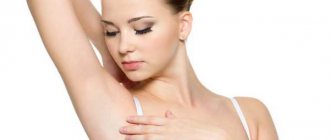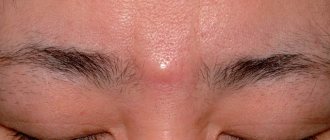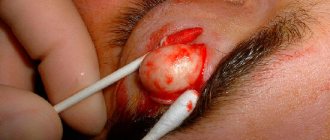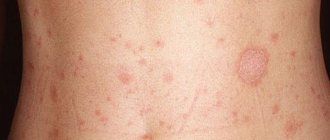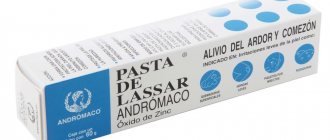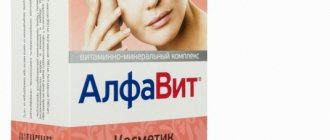Redness of armpits after shaving
Underarm redness is most often caused by shaving, especially in people with sensitive skin or some forms of dermatitis.
Removing armpit hair with a razor is quick and cheap. A razor blade can damage the skin and make it easier for bacteria to enter, which can cause an inflammatory reaction. After shaving, you need to apply a soothing cream or gel to the skin, which relieves inflammation, softens the skin and has an anti-inflammatory effect.
If you don't have cream, you can reduce the redness caused by shaving with an aspirin tablet. It is necessary to dissolve two tablets in a small amount of water to obtain a paste consistency. Then you need to carefully apply it to the irritated areas of the armpits, let it dry, and then rinse with a small amount of water.
Be extremely careful with this and other home remedies. The active ingredient in home remedies is often a drug whose exact concentration is unknown. As a result, numerous skin lesions and irritations can occur.
Razor irritation can be reduced by cooling the affected area with cool water or an ice cube. There are also special sprays with thermal water that have an anti-inflammatory effect and help regenerate the skin.
If you frequently have problems with armpit redness after shaving, you may want to consider other hair removal methods, such as sugar paste waxing or laser hair removal.
If redness on the skin of the armpit is accompanied by pain, palpable lumps with or without a purulent tip, you should consult a doctor. Most often this is inflammation of the hair roots, but it is also possible that it is inflammation of the glandular ducts of the skin. These conditions usually lead to local or systemic antibiotic therapy.
Causes of the rash: what causes a pimple in the armpit to hurt?
The causes of a rash in the armpit may be as follows:
- Increased sweating. Pimples can appear due to hyperhidrosis. Together with sweat, toxins are released, which, with prolonged contact with the skin, can cause irritation in the form of redness, rash, itching, and burning.
- Failure to comply with hygiene rules. In continuation of the first point, it is worth noting that it is necessary to combat increased sweating not only with the help of antiperspirants, but also by observing the rules of hygiene. In the summer, you need to shower more often.
- Allergy to hygiene products or reaction to comedogenic components in cosmetics. Especially often girls who use a large number of hygiene products and cosmetics encounter a rash in the armpits. Excessive use of deodorants, shower gels, and greasy creams can lead to clogged pores. The presence of comedogenic components in the composition of the products can also cause a rash. It is not uncommon to experience allergies to ingredients that are part of gels or antiperspirants.
- Sensitive skin. Women take a responsible approach to choosing face creams, taking into account their skin type (normal, oily, problematic, dry), but they do not always treat their body carefully. Owners of sensitive skin, which is picky about the composition of care products, should be especially careful when selecting body cosmetics.
- Depilation. After shaving, ingrown hairs and dense infiltrates may appear.
Sensitivity to deodorants and depilatory creams
Sensitivity to deodorants, colored clothing, detergents or depilatory creams due to a number of chemicals they contain can cause redness under the arms, scaly rashes and dandruff, burning and itching. In the worst case scenario, red bumps and blisters may appear, secreting the secretion. Then you need to see a doctor as soon as possible.
A skin reaction to deodorant may occur after the first use, as well as after several months of exposure. If a skin reaction occurs, your doctor may prescribe antihistamines or corticosteroid creams and order an allergy test.
People with atopic dermatitis are more likely to have reactions to deodorants, hair removal creams, and other irritants. To avoid inflammatory conditions, it is recommended to use unscented and alcohol-free deodorants, as well as natural-based deodorants without irritating chemicals.
Avoid using depilatory creams if you feel a burning sensation after application and notice redness after removing the cream.
What to do if a pimple in the armpit area hurts?
In addition to aesthetic discomfort, the rash may be accompanied by itching, burning, and pain. If a pimple in the armpit area hurts, you should consult a dermatologist to find out the cause of its occurrence. Sometimes acne can be combined with hidradenitis, and the doctor will prescribe complex treatment for different areas. To combat mild to moderate acne, your doctor may recommend azelaic acid, for example, Azelic®9 gel.
This is a drug that helps reduce the level of free fatty acids and normalize keratinization processes5. Azelik® gel exhibits antimicrobial activity against Propionibacterium acnes and Staphylococcus epidermidis5. The anti-inflammatory effect of the drug is based on the ability to reduce the metabolism of neutrophils and their production of free radical forms of oxygen5.
Redness caused by fungi
Redness under the arms can be the result of a fungal skin infection called tinea capitis. Most often, this is candidiasis-dermatomycosis, caused by yeast of the genus Candida (most often Candida albicans). They are an integral part of a healthy body, but can cause problems if they multiply excessively. This occurs when the body’s immune defense is weakened (stress, exhaustion, antibiotics).
An important role in the development of these skin changes is played by local damage to which candida easily “attaches.” The fungus then manifests itself as an infection that affects the entire body (systemic infection) or specific parts of it, such as nails, skin, scalp or mucous membranes (vaginal candidiasis, candidiasis of the digestive system, skin infection - ringworm).
Most often, ringworm occurs in skin folds, under the arms, on the chest and in the groin. It begins with mild itching, followed by redness, cracking, and marginal peeling of the skin. It is treated with antifungal creams under the supervision of a dermatologist.
To prevent the development of dermatomycosis, it is necessary to keep the areas of skin folds clean and dry, since moisture promotes the growth of fungi. Fungal infections are also more common in areas where there are large numbers of people, such as schools, daycare centers and swimming pools. Therefore, after visiting public areas, it is recommended to take a shower and dry thoroughly with a towel so that moisture does not get into the armpits and other folds of the skin.
Folk remedies
The reasons for the appearance of red spots can be different, each of them requires an individual approach when choosing a treatment method. With the appearance of such symptoms, folk remedies that use medicinal plants and products available in every home in their recipes are quite effectively dealt with.
A mixture of poplar and birch buds infused with alcohol is no less effective in reducing the activity of the fungus. The kidneys are crushed in equal quantities and infused in good vodka or alcohol. Before treating the skin, alcohol is diluted with water.
The fungus responds well to treatment with tar; for this purpose, pharmaceutical purified tar and tar soap are used.
Fungal diseases are treated with garlic or radish compresses, however, this remedy should be applied carefully to skin with weeping rashes. It helps well by relieving the symptoms of itching and eliminating inflammatory processes, decoctions of chamomile, lingonberry leaf, St. John's wort - they are brewed and drunk as tea.
Decoctions of chamomile, lingonberry leaf, and St. John's wort herb help well by relieving the symptoms of itching and eliminating inflammatory processes - they are brewed and drunk as tea.
If discomfort in the armpit area is associated with sweating, you can get rid of it with chamomile infusion. Pour 1 spoon of herb with a glass of boiling water. Let stand for 20 minutes, strain. Pour 2 tablespoons of apple cider vinegar into the product. Wash irritated areas 3-4 times a day.
In hot weather, a decoction of oak bark will be a means of controlling sweat. It has an astringent effect and normalizes the functioning of the sweat glands.
You can wash the axillary area with a solution of sea salt (2 tablespoons per 0.5 liters of water). Before use, strain through several layers of gauze.
What to do if you are irritated?
The appearance of redness and discomfort in the armpits is a reason to listen more closely to your own body. For such symptoms, it is recommended:
- Reconsider your attitude towards armpit care.
- Change your usual lifestyle a little.
- Seek medical help.
- Use local and/or systemic medications that suppress unpleasant symptoms.
- Use traditional medicine (preferably after doctor’s approval).
It is quite possible to deal with the initial irritation on your own at home. But if unpleasant symptoms worsen, constantly recur and significantly disturb the general condition, it is better not to hesitate to visit a doctor.
General recommendations
If signs of irritation appear under the arms, doctors recommend:
- Avoid shaving hair in this area for a while, as well as using other methods of depilation. Subsequently, for shaving you need to use only a good sharp razor, and this procedure should be carried out exclusively on clean skin, moistened with special products.
- Stick to a diet. It is important to avoid eating spicy, fatty foods, sweets and baked goods, as well as alcohol. It is best to saturate your diet with fresh vegetables and fruits.
- Avoid synthetic clothing. Use products made from natural fabrics that are lightweight, can absorb and evaporate moisture, and are ventilated.
- Shower regularly. Such a recommendation may be irrelevant only if pustules appear under the armpits - signs of pyoderma. In such a situation, it is better to avoid showering before visiting a doctor, and treat the affected areas with antiseptics.
- Avoid using shower gels and soaps with different fragrances. To wash your armpits, it is better to use ordinary hypoallergenic baby soap.
- Do not injure delicate skin with a towel. Wet armpits should not be rubbed, but blotted dry. For this purpose, you can use not only a towel, but also paper napkins.
- Treat the skin with regular baby powder. This simple remedy will help remove excess moisture and soften friction, helping to eliminate unpleasant symptoms. On sale you can find powder with additional components, for example, zinc, which will have more pronounced drying properties.
Why did the child have redness?
Irritation in the armpits in children is in the vast majority of cases associated with insufficient hygiene and excessive sweating. Thus, young children often show signs of prickly heat in their armpits, especially if parents wrap their children up and rarely bathe them, thus trying to protect them from the disease. In older children, redness often appears after active pastime and refusal of a daily shower.
Dermatological diseases and allergic reactions in the armpit area occur extremely rarely in children. However, if parents cannot cope with the usual redness within a few days, it is better to seek medical help from a pediatrician or dermatologist.
Diagnostics
General surgeons and oncologists are most often involved in determining the causes of pain in the armpit. Depending on the etiology of the disease, consultations with a traumatologist, dermatologist, and other specialists are prescribed. The examination program includes:
- Survey
. The doctor finds out when and under what circumstances the pain syndrome first appeared, what symptoms were accompanied, how the pathology developed, whether the pain is related to external circumstances, and whether it is cyclical. - Visual inspection
. When conducting an objective examination, the specialist evaluates the appearance of the axillary area, identifies swelling, hyperemia, skin defects, determines the range of movements, and palpates bones, muscles, ligaments and lymph nodes. - Ultrasonography.
Sonography of soft tissues confirms inflammation or damage to ligaments and muscles, and the presence of space-occupying lesions. During an ultrasound of the lymph nodes, lymphadenopathy is detected, the size and contours of accumulations of lymphoid tissue, and their relationship with other structures are examined. - Radiography.
In case of injuries, an X-ray examination of the shoulder joint is prescribed; in case of lymphadenopathy, middle-aged and older women undergo mammography. Young patients are more likely to undergo breast ultrasound. - Needle biopsy.
It is carried out if tumor formations are suspected. Allows you to establish the structure and degree of differentiation of cells, confirm the presence of regional lymphogenous metastases. - Lab tests.
They indicate the presence of inflammatory processes and allow one to assess the condition of the body in severe diseases.
Ultrasound of lymph nodes in the axillary region
Folk remedies
- birch decoction lotions;
- rubbing with chamomile tincture (a spoonful of dry raw materials is steamed with a glass of boiling water, infused, filtered, a couple of spoons of apple cider vinegar are added);
- rubbing with St. John's wort tincture (two tablespoons of plant material are poured with boiling water and infused);
- rubbing with a decoction of oak bark (pour a tablespoon of oak bark into a glass of boiling water and leave for two hours);
- rubbing with saline solution (two teaspoons of sea salt dissolved in a glass of hot water);
- wiping the affected areas with boiled sunflower oil;
- tobacco compresses (put a handful of tobacco on a bandage, moisten with a strong solution of potassium permanganate) are placed on the armpits at night.
Reviews
Dear readers, your opinion is very important to us - therefore, we will be glad to hear your feedback about armpit irritation in the comments, this will also be useful to other users of the site.
I have very sensitive skin, irritation occurs not only after shaving my hair, but also after using deodorants. For a long time I couldn’t find a way out and I didn’t want to walk around with the smell of sweat. There seems to be no irritation from Crystal now, but from time to time I lubricate my skin with Dermatop ointment. It helps a lot.
https://www.youtube.com/watch?v=CrYLfP6TdWY
My mother is overweight, and over the years it has become increasingly difficult for her to walk, and she began to sweat a lot. As a result, severe irritation develops under the arms and in the groin area. Once, against the background of irritation, a lighter spot formed, which was very itchy. After visiting a doctor, he was diagnosed with a fungal infection, which was removed with Lamisil.
Prevention
Allergies from sweat are quite common. It is impossible to completely get rid of the disease. But thanks to special preventive recommendations, you can control your condition to avoid an unpleasant reaction to sweat. To avoid the discomfort associated with increased sweating, you need to:
- Refuse to wear things made of synthetic materials.
- Do not be exposed to sunlight for a long time.
- Do not visit baths, saunas, or take a hot bath.
- Completely eliminate certain foods from your diet. Allergy sufferers are contraindicated in anything hot, spicy, salty or spicy, as under the influence of these dishes an increase in sweating occurs.
- Observe personal hygiene rules.
- To get rid of excessive sweating, you need to use special talcum powder.
- Monitor your emotions, as during excessive emotions there is an increase in sweat secretion.
An allergic reaction to sweat can cause a lot of trouble for a person. There are no medications that can help get rid of the disease. But following preventive advice will help alleviate the condition and improve the quality of life.
Therapy
All therapeutic measures are aimed at eliminating the manifestations of the disease and reducing sweating. To achieve the first goal, systemic and local antihistamines are used. They are the main part of symptomatic therapy.
Good results are achieved with Cetirizine and Akrivastine. They should be taken several hours before physical activity or other provoking factors.
Expert opinion
Allergist Yulia Borisovna Cherkashina
Education: Medical University named after. N.I. Pirogov, Moscow, 1998
In some cases, ointments containing glucocorticosteroids are prescribed. Such medications should be selected by the doctor individually for each case.
To solve the problem of excessive sweating, several techniques are used:
- Special medications are used. Under their influence, sweat secretion decreases.
- Treatment is carried out with drugs to block acetylcholine.
- Physiotherapeutic procedures are prescribed. Salt baths help reduce skin irritation from sweat.
- Sedatives are used, as sweating increases under the influence of excessive emotionality. In most cases, they resort to valerian extract, Persen, Novopassit. The preparations contain extracts of lemon balm, valerian, St. John's wort, hops, and hawthorn.
If increased sensitivity to sweat is associated with chronic diseases, then it is necessary to treat the underlying pathology.
Very often, doctors are asked what to do if the husband’s sweat causes allergies. To prevent this problem from causing discomfort, preventive measures must be taken.
It is recommended to follow a hypoallergenic diet, since a negative reaction of the body may be associated with certain foods.
Causes of prickly heat in adults and children
Among the provoking factors, a number of the most common ones can be identified:
- Wearing clothes made from non-breathable materials.
- Working in a hot room with high humidity.
- Endocrine pathology – thyrotoxicosis, diabetes mellitus.
- Obesity.
- Hormonal shift – menopause, puberty.
- Diseases that occur with high fever.
- Injuries and abrasions of the skin.
- Insufficient hygiene.
- The use of cosmetics that clog pores.
In infants, heat rash is predominantly caused by incompletely formed sweat glands. If proper measures are not taken, prickly heat will lead to diaper rash.
Features of the treatment of urticaria at the Gorbakov Clinic:
- Individual patient training at the immuno-school and asthma school.
- Treatment begins on the first day of treatment.
- A comprehensive examination is carried out on the day of treatment.
- Return to normal life.
- Rapid relief of a serious condition occurs within 1-3 days.
Urticaria is an extremely common allergic disease, affecting one in five people worldwide. Most often, people do not attach importance to the symptoms and rarely consult a doctor if they notice characteristic rashes. However, urticaria is often a signal of the presence of serious diseases in the body. Contact a specialist at the first symptoms of allergic urticaria and undergo the recommended comprehensive examination.
It’s good to be healthy, but unfortunately, we can’t always boast of an excellent state of mind and body. Everyone has heard about hives. This is a fairly common allergic disease that can be acquired at any age. Ruthless statistics say that 15-20% of the population of our planet have observed at least one case of urticaria throughout their lives.
Urticaria is a widespread disease that manifests itself in the form of characteristic rashes, similar to nettle burns, on the skin and mucous membranes. Rarely accompanied by itching.
In childhood, each of us was inadvertently burned by nettles, so it is quite easy to imagine the symptoms of this disease. Hippocrates was one of the first to talk about this seemingly simple disease. He drew an analogy between urticarial rashes in people suffering from hives and problems of the gastrointestinal tract.
Causes of urticaria
Very often, the cause of hives is an allergic reaction of the body to certain substances (allergens). There are different ways that allergens enter the body, depending on which urticaria occurs:
- food (citrus fruits, seafood, pork, nuts, eggs, tomatoes, berries or other products are the culprits);
- insect (as a result of insect bites), including those resulting from infection with parasites (helminths, ticks);
- medication (for penicillin, aspirin, codeine and other drugs);
- result of stress;
- toxic allergy;
- as an individual reaction to cold, heat, prolonged ultraviolet irradiation.
In all of the above cases, you need to consult an allergist.
Classification of the disease
There are two forms of urticaria:
- acute (duration is about 6 weeks);
- chronic (over 6 weeks).
There are different types of immunological urticaria:
- urticarial vasculitis;
- allergic;
- compliment dependent;
- autoimmune.
Physical urticaria is divided into:
- mechanical urticaria:
- vibration;
- dermographic;
- temperature urticaria:
- thermal;
- cold contact;
- allergies that develop under the influence of other extraneous factors.
There are also such forms of the disease:
- contact;
- aquagenic;
- adrenergic;
- urticaria, which is caused by non-IgE-mediated degranulation of mast cells;
- cholinergic;
- drug-induced urticaria with development mechanisms different from those previously described;
- idiopathic (if the cause of urticaria is not established);
Symptoms of urticaria
A blister is the primary element in the manifestation of a skin rash. It is a local swelling of the papillary dermis, which occurs due to accelerated blood flow, vasodilation and increased vascular permeability.
Blisters can be either pinpoint or large-focal, sometimes they merge with each other.
Blisters may also appear as cavityless exudative ephemeral elements. Dense, swollen, bright pink in color, they can rise above the skin level and have different shapes (large scalloped, rounded, etc.), different sizes (diameter - from 0.5 to 10-15 cm) and often a pale area in the center. Blisters may disappear without a trace (even after a few minutes).
There may be a burning sensation or an unpleasant itching sensation.
The duration of the visual presence of the rash can range from several minutes to a day.
In half of the patients, urticaria is accompanied by angioedema (Quincke's edema).
If swelling and rash have spread to the surface of the mucous membranes of the gastrointestinal tract, nausea and vomiting have appeared, this indicates a possible threat to human life and requires immediate intervention by a specialist.
Very often, urticaria is not treated and the disease is not given due importance. However, it is important to know that hives can be a signal of an infection in the body.
Do not forget about the predisposition to urticaria. This will be indicated by increased sensitivity of the skin and white stripes that remain after light scratching (white dermographism). If hidden infections are detected in time, the immune system will be able to function normally. It is important to assess the condition of the internal organs, being aware that if their functioning is disrupted, skin diseases may occur.
Brief description of some clinical forms of urticaria
Allergic urticaria:
- often occurs acutely or episodically;
- the most common allergens are food, medications, insect poison, latex;
- Patients also have other manifestations of allergopathology, the so-called allergic heredity;
- the results of the allergy examination are positive;
- Elimination measures are effective.
Autoimmune urticaria:
- characterized by a course of chronic idiopathic urticaria;
- frequent presence of autoimmune thyroiditis and thyroid disease in the family;
- severe general symptoms (weakness, malaise, gastrointestinal dysfunction);
- the presence of histamine-releasing anti-Fcε-RI antibodies and anti-IgE antibodies;
- the autoserum test is positive.
Cold urticaria:
- can be acquired or arising against the background of an underlying disease (for example, viral hepatitis, lymphoproliferative disease and others) and congenital;
- the appearance of itching, burning, hyperemia, urticarial rash, angioedema in areas of the skin exposed to low temperatures;
- symptoms persist for 20-30 minutes and disappear without a trace after the patient warms up.
Delayed pressure urticaria:
- characterized by the appearance of swelling and blisters in pressure areas 4-6 hours after exposure; Inflammation can occur anywhere. But most often, skin rashes appear in places where skin and clothing come into close contact: under straps, belts, and suspenders.
- characterized by resistance to treatment.
Heat urticaria:
- occurs from exposure to heat;
- hereditary local thermal urticaria has been described, characterized by a delayed (4-6 hours) appearance of elements after local thermal exposure;
- may be accompanied by systemic circulatory disorders and convulsive syndrome.
Solar urticaria:
- occurs under the influence of ultraviolet radiation;
- blisters appear on exposed areas of the body after exposure to the sun, there may be fixed light urticaria;
- the disease can be primary (idiopathic light urticaria) and secondary;
- secondary light urticaria can be associated with the action of drugs (tetracyclines, sulfonamides, quinolones) or with an underlying disease (systemic lupus erythematosus, thyroiditis, gastrointestinal dysfunction).
Dermographic urticaria:
- the appearance of blisters due to mechanical irritation of the skin;
- itching precedes the appearance of rashes;
- the phenomenon of dermographism is reproduced by intense line irritation of the skin with a blunt object (spatula).
Vibration urticaria/angioedema:
- there are hereditary (autosomal dominant type) and acquired forms;
- characterized by the appearance of a rash and swelling in areas exposed to vibration;
- rash and swelling appear 4-6 hours after exposure to vibration and persist for up to 24 hours;
- the disease is caused by nonspecific degranulation of mast cells.
Aquagenic urticaria:
- the rash occurs only after contact with water of any temperature;
- the rash appears instantly;
- presents as small blisters surrounded by erythematous spots.
Cholinergic urticaria:
- occurs more often in young people;
- characterized by the appearance of pale pink blisters with a diameter of 1-5 mm, often surrounded by erythema;
- the rashes are generalized;
- provocative factors are physical exercise, stress, sweating, hot shower;
- may be accompanied by systemic manifestations (hot flashes, weakness, rapid heartbeat, headache, abdominal pain, shortness of breath);
- can be reproduced by subcutaneous administration of acetylcholine.
Adrenergic urticaria:
- rare;
- characterized by the appearance of small papules with a white halo;
- triggered by stress;
- can be reproduced by intradermal injection of adrenaline.
Symptoms of urticaria
- Blisters can appear as pinpoint or large-focal, sometimes they merge with each other.
- A blister, the primary element in the manifestation of a skin rash, is a local swelling of the papillary dermis, which occurs as a result of accelerated blood flow, vasodilation, and increased vascular permeability.
- Blisters may also appear as cavityless exudative ephemeral elements. Dense, swollen, bright pink in color, they can rise above the skin level and have different shapes (large scalloped, rounded, etc.), different sizes (diameter - from 0.5 to 10-15 cm) and often a pale area in the center. Blisters may disappear without a trace (even after a few minutes).
- Sometimes there may be a burning sensation or a blister may be accompanied by unpleasant itching of the skin.
- Inflammation can occur anywhere. But most of all skin rashes appear in places where skin and clothing come into close contact: under straps, belts, and suspenders.
- The duration of the visual presence of the rash can range from several minutes to a day.
- In half of the patients, urticaria is accompanied by angioedema (Quincke's edema).
If swelling and rash have spread to the surface of the mucous membranes of the gastrointestinal tract, nausea and vomiting have appeared, this indicates a possible threat to human life and requires immediate intervention by a specialist.
Very often, urticaria is not treated and the disease is not given due importance. However, it is important to know that hives can be a signal of the appearance of diseases of the internal organs or some other serious infection in the body.
Do not forget about the predisposition to urticaria. This will be indicated by increased sensitivity of the skin and white stripes that remain after light scratching (white dermographism). If hidden infections are detected in time, the immune system will be able to function normally. It is important to assess the condition of the internal organs, being aware that if their functioning is disrupted, skin diseases may occur.

